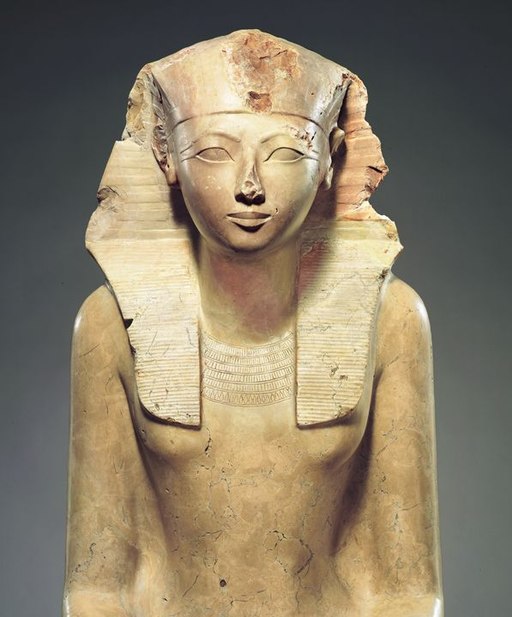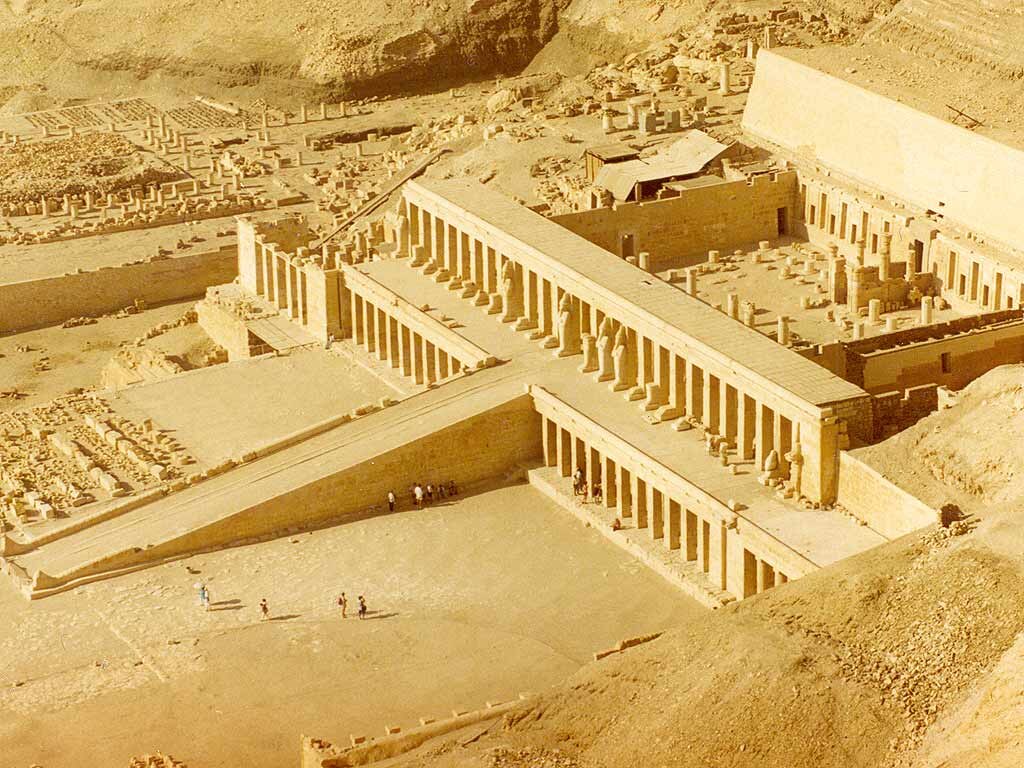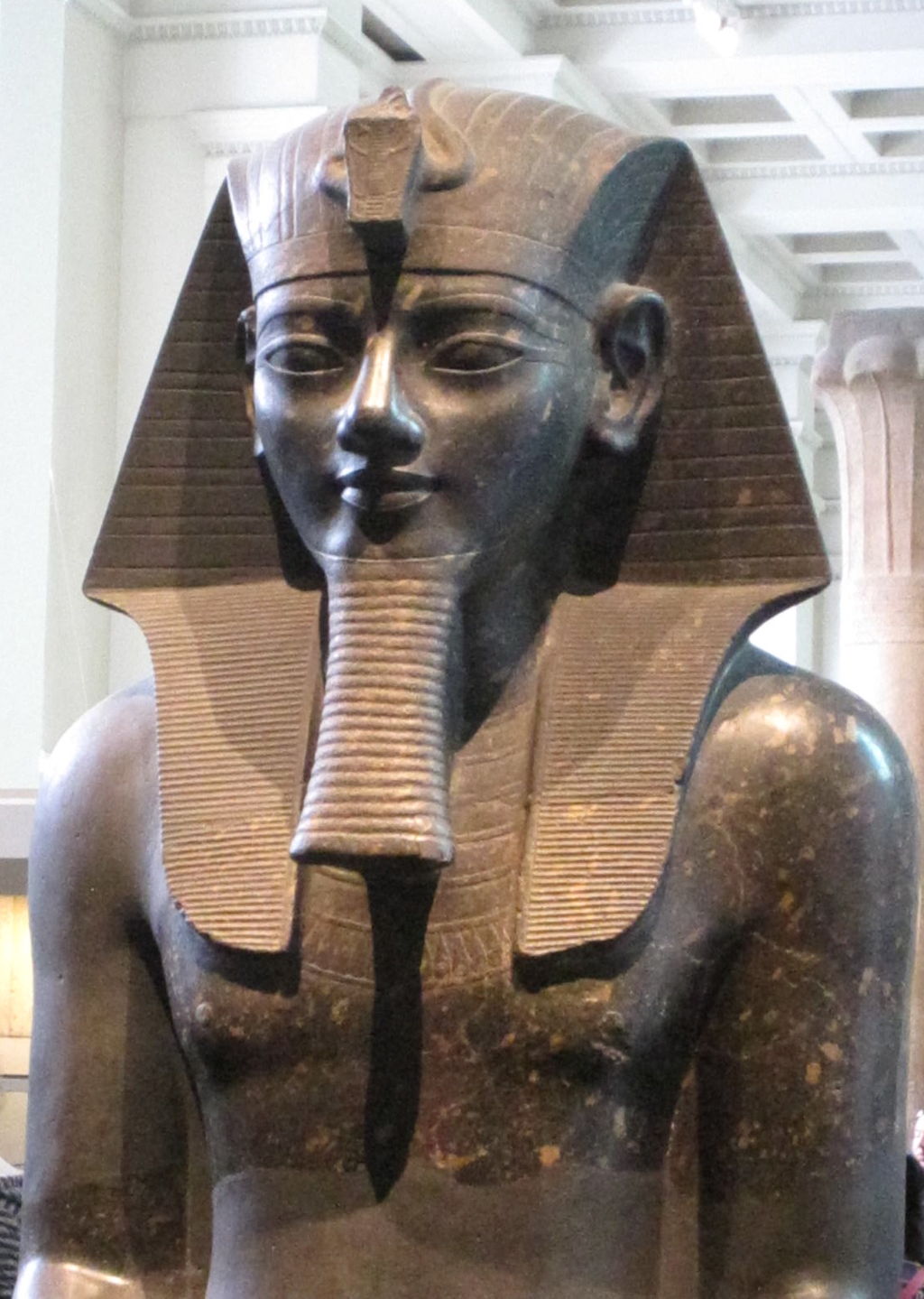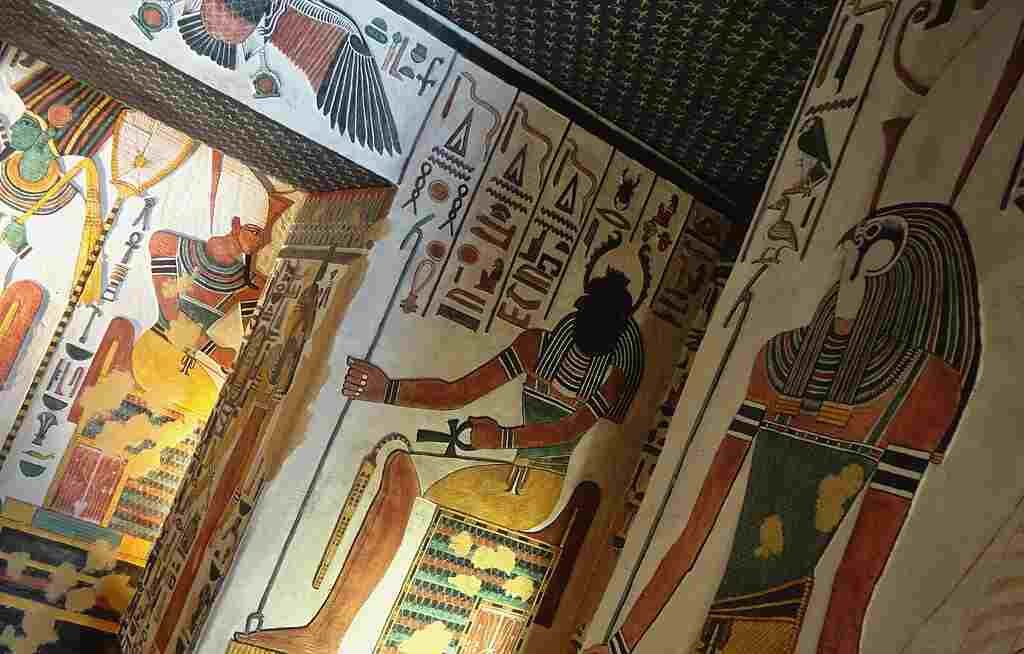List of Egyptian dynasties – Ancient Egypt
Timeline of Egyptian history and bibliography. Find the key dates and a selection of works the Egypt Dynasty.
The history of Egypt is written over a particularly long time. It must be said that if the country as such has only existed for a hundred years, the Egyptian civilization appeared from the Neolithic era and was structured from 3400 BC. And as Egypt still exists, its history is extremely dense. Hence the interest of detailing it through a few key dates.
The rest of this document is therefore a chronology of the history of Egyptian dynasties through the major dates of its history.
-5000/-3000: Neolithic or predynastic period
The Egyptian predynastic period is still relatively unknown. It preceded the unification of the country and the centralization of powers in the hands of the pharaonic dynasties. It is also called protodynastic period. The predynastic era ends, as its name suggests, with the creation of the first pharaonic dynasty. It occurs with the unification of the country by Narmer.
The name “dynasty 0” is sometimes given to the kings who succeeded one another until Narmer around 3100 to 3000 before the Christian era. It was during this last period that writing appeared in Egypt in the form of hieroglyphics.
1st Dynasty of Egypt (3150 BC – Circa 2850 BC)
The First Egyptian Dynasty, at the end of the 4th millennium BC, marked the beginning of more than three millennia of pharaonic institution with the unification of ancient Egypt, until then divided into two distinct kingdoms, that of the North and that of the South, and lasts from 3150 BCE to approximately 2850 BCE.
Tradition attributes this reunification to King Narmer, although he is not part of the 1st dynasty and is generally classified in the predynastic period.
The first dynasty opens the Thinite period, from the Greek name of the capital of the first two dynasties, Thinis (Tjene in Egyptian).
-3300/-3100: unification of Egypt and appearance of hieroglyphs
Egypt is united into a single kingdom by the first kings.
Hieroglyphs appear for the first time around -3100 BC. Their meaning will not be understood until much later by Champollion who manages to decipher the Rosetta stone.
-2625/-2605: reign of Djeser or Djoser
Old Kingdom, Third Dynasty. Djeser was renowned for his authority and fairness. He is one of the greatest Egyptian pharaohs.
During his reign, Egypt experienced peace. Its prime minister had the first step pyramid built in Saqqara by the architect Imhotep. It is the oldest pyramid in Egypt.
-2600/-2590: reign of Sneferu
Old Kingdom, 4th dynasty. Snefru is the founder of the Fourth Dynasty. He developed trade with the current Middle East. The most famous construction of his reign is the rhomboidal pyramid, so called because of its particular shape: halfway up the construction, the slope breaks and the pyramid becomes rounded.
-2590/-2498: construction of the pyramids of Giza
Old Kingdom, 4th dynasty. These three pyramids were built for the pharaohs Kheops (-2590/-2565), Khephren (-2558/-2533) and Mykerinos (-2530/-2510).

Great Sphinx of Giza and the pyramid of Khafre. Most likely Hamish2k, the first uploader, CC BY-SA 3.0, via Wikimedia Commons
Cheops is the builder of the first wonder of the world. Its pyramid was then 147 meters high. His reign is poorly known. Khephren is one of the most famous pharaohs of the Fourth Dynasty. His most important achievement is the Great Sphinx of Giza. Mykerinos had the smallest of the three pyramids built (66 meters or 216.5 ft). He is the last pharaoh to have had one built.

Statuette of the sitting king Cheops of the 4th ancient Egyptian dynasty (height: 7.5 cm, width: 2.5 cm, depth: 2.9 cm), found 1903 in Abydos, exhibited at the Egyptian Museum in Cairo, Egypt. Olaf Tausch, CC BY 3.0, via Wikimedia Commons
-1991/-1785: golden age of Egyptian literature
Middle Kingdom, XIIth dynasty which includes seven pharaohs. This is the period when Egyptian literature develops (teachings, novels, tales). Ammenemes I built the temple of Karnak.

The Karnak Temple. The Great Hypostyle Hall, Precinct of Amun-Re. The structure was built around the 19th Egyptian Dynasty (c. 1290-1224 BC). Luxor, Egypt. © Vyacheslav Argenberg / http://www.vascoplanet.com/, CC BY 4.0, via Wikimedia Commons
-1490/-1468: Hatshepsut, the only female “pharaoh”
New Kingdom, 18th dynasty. She first assumed power in the name of her son – regency period – before taking her place on the throne of Egypt. She launches great expeditions to the south of the Red Sea. She is the only known female “pharaoh”.

Seated Statue of Hatshepsut, Eighteenth Egypt dynasty, c. 1473-1458 B.C. Metropolitan Museum of Art, CC0, via Wikimedia Commons

Hatshepsut’s Temple colonnaded structure. The Temple of Hatshepsut is built into a cliff face that rises sharply above it. A turning point in the megalithic geometry of the Old Kingdom. Deir el-Bahari with temples of Hatshepsut, Thutmosis III and Mentuhotep II, Thebes, Luxor, Egypt. Ian Lloyd, CC BY-SA 3.0, via Wikimedia Commons
-1403/-1365: Amenophis III also called Amenhotep III, the peak of the 18th dynasty
New Kingdom, 18th dynasty. Amenophis is a great builder. His reign marks the peak of his dynasty. This is the period of construction of the Temple of Luxor and the sculptures of the Colossi of Memnon, and the enlargements of Karnak.

Statue Colossal Amenhotep III in British Museum. Amenophis III also called Amenhotep III was a pharaoh of the 18th dynasty who ruled Egypt for approximately forty years (ca. 1390-80 and 1350-40 BC), his reign being prosperous and stable. A. Parrot, Public domain, via Wikimedia Commons
-1365/-1347: reign of Amenhotep IV or Akhenaton
New Kingdom, 18th dynasty. He undertakes with his wife Nefertiti to impose a monotheistic religion. Aten, the solar disk, becomes the only god. He changes his name to Akhenaten, which means “one who is beneficial to Aten”. He reigned for seventeen years but when he died his religion and the changes he had imposed disappeared with him. His statues, his monuments were destroyed erasing his name from stone.

Figure of Ancient Egyptian Amenhotep IV / Akhenaton. Amenhotep IV reigned in ancient Egypt in the first half of the 14th century BC, around 1350 to 1335 BC. See page for author, CC BY 4.0, via Wikimedia Commons
-1347/-1305: reign of Tutankhamun
Tutankhamun, commonly referred to as King Tut. (born around -1345, died around -1327) is the eleventh pharaoh of the XVIIIth dynasty (New Kingdom). His reign is poorly known. He is said to have ascended the throne at the age of ten and died under mysterious circumstances when he was only in his twenties. His tomb was discovered in the Valley of the Kings in 1922 by Howard Carter. It is one of the only tombs not to have been looted.

Replica of the second sacophagus from the tomb of Tutankhamun. Jl FilpoC, CC BY-SA 4.0, via Wikimedia Commons
-1279/-1213: reign of Ramses II, called the Great
New Kingdom, 19th Dynasty. He ruled Egypt for sixty-six years, with the help of his wife Nefertari, until the age of 90. She was not his only wife. He married eight times and it is estimated that by the end of his life he had had around 100 children. He was victorious in a large number of military campaigns. Ramses II was a great builder. Under his reign, many monuments such as the colossal statues in his image of Abu Simbel and the obelisks of Luxor were built. We also owe him the extension of the temple of Karnak and he built a magnificent tomb for his wife Nefertari in the Valley of the Queens.

Colossus statue of Ramses II standing between the columns of the Luxor Temple. Olaf Tausch, CC BY 3.0, via Wikimedia Commons
-332/-330: Egypt becomes Greek
Third intermediate period. Egypt is ruled by Persian kings. After the battle of Issos, Darius III, defeated, fled. Alexander the Great seizes Egypt and founds the city of Alexandria. On his death, one of Alexander’s generals, Ptolemy, takes the title of king of Egypt. This is the beginning of the Ptolemaic dynasty.
-237: beginning of the construction of the temple of Edfu
Built during the reign of the last pharaohs, the temple of Edfu is dedicated to Horus. It is in an excellent state of conservation because it was covered for years by sand on which a village had settled. It was discovered in the 19th century during archaeological excavations. It is one of the largest temples in Egypt.

The Temple of Edfu is an Egyptian temple dedicated to Horus and Hathor, one of the best preserved temples in Egypt. 57 BC. Edfu, Aswan, Egypt. © Vyacheslav Argenberg / http://www.vascoplanet.com/, CC BY 4.0, via Wikimedia Commons
-51/-30: reign of Cleopatra, last queen of Egypt
This is the Ptolemaic period. Cleopatra wants to restore Egypt to greatness in the face of the increasingly powerful Roman Empire. Dismissed from power by her brother Ptolemy XIII, she manages to convince Caesar to invade the kingdom of Egypt in order to leave him the throne. She manages to bring her kingdom back to the fore, but it threatens Rome.

Cleopatra, Queen-Pharaoh of Egypt. Bust of Cleopatra VII known as Cleopatra (Altes Museum, Berlin), the most likely portrait of the queen. © José Luiz Bernardes Ribeiro (CC BY-SA 4.0)
-30: Egypt becomes a Roman province
Marc-Antoine and Cleopatra join forces to fight against the armies of Octave. But they are defeated at the Battle of Actium. Cleopatra committed suicide by being bitten by an asp. His death marks the end of Egyptian civilization. Egypt becomes Roman.
List of pharaohs ordered by period and dynasty
The table below presents a (non-exhaustive) list of pharaohs, listed in chronological order and grouped by dynasty and period. This list is a compilation of many reference sources on the subject. To avoid overloading this table, only the dates of the periods are displayed. For the dates of the dynasties, the reign of the pharaohs or simply for more information, we invite you to click on the links (learn more).
The reign dates given here are approximate. Indeed, they vary according to the specialized authors. This is the reason why, you can find differences (more or less big) depending on the source used.
The name displayed for each pharaoh in this table is the one most commonly encountered in French-speaking Egyptology. Finally, pharaoh names followed by a (?) are pharaohs whose existence is not proven.
Rosetta Stone | Without It, We Won’t Know About the Ancient Egypt
The Predynastic Period (~3400 to ~3150) | |
| Dynasty Zero (or Nagada III) | Horus au Serekh |
| Horus Ny-Hor | |
| Horus Hat-Hor | |
| Horus Iry-Ro | |
| Horus Ka | |
| Horus Scorpion | |
The Thinite Period or the Archaic Period (~3150 to ~2700) | |
| 1st Dynasty | Meni or Menes |
| Narmer | |
| Haha | |
| Djer | |
| Ouadji | |
| Jet | |
| Den | |
| Adjib | |
| Semerkhet | |
| Qaa | |
| 2nd Dynasty | Hotepsekhemwy or Hotep |
| Nebre or Reneb | |
| Nineter or Binothris | |
| Ouneg | |
| Snedj | |
| Horus Sekhmeb | |
| Peribsen | |
| Khasekhem | |
| Khasekhemwy | |
| Djadjay or Beby | |
The Old Kingdom (~2700 to ~2190) | |
| 3rd Dynasty | Nebka (?) |
| Senakht | |
| Djoser or Djose | |
| Sekhemkhet | |
| Khaba | |
| Neferkare (?) | |
| Huni | |
| 4th Dynasty | Snefrou |
| Khoufu or Cheops | |
| Djedefre | |
| Khaefre or Chephren | |
| Menkaouré or Mykerinos | |
| Chepseskaf | |
| 5th Dynasty | Userkaf |
| Sahoure | |
| Neferirkare | |
| Shepseskare | |
| Neferefre | |
| Nyuserre | |
| Menkauhor | |
| Djedkare | |
| Unas | |
| 6th Dynasty | Teti |
| Userkare | |
| Pepi I | |
| Merenre I | |
| Pepi II (read more) | |
| Merenre II | |
| Nitokris | |
The First Intermediate Period (~2190 to ~2022) | |
| 7th Dynasty known as of Memphis | According to Manetho, there were 70 pharaohs in 70 days. The few sources that have come down to us from this period do not allow us to retrace the story. |
| 8th Dynasty known as of Memphis | Just like the VIIth dynasty, the succession of the VIIIth is very fragmentary due to the scarcity of sources. One of the only pharaohs whose existence we are certain of is: Qakarê-Ibi |
| 9th Dynasty known as Herakleopolis | Meribre Khety I |
| Merikare | |
| Neferkare VII | |
| Khety II | |
| Khety III | |
| Khety IV | |
| 10th Dynasty known as Herakleopolis | Khety V |
| Khety VI | |
| Khety VII | |
| Merikare | |
| 10th Dynasty (beginning) | Mentuhotep I |
| Intef (Antef) I | |
| Intef (Antef) II | |
| Intef (Antef) III | |
| Le Moyen Empire (~2022 à ~1786) | |
| 11th Dynasty (continued) | Mentouhotep II |
| Mentouhotep III | |
| Mentouhotep IV | |
| 12th Dynasty | Amenemhat Ir |
| Sesostris I | |
| Amenemhat II | |
| Sesostris II | |
| Sesostris III | |
| Amenemhat III | |
| Amenemhat IV | |
| Neferousebek | |
The second intermediate period (~1786 to ~1552) | |
| 13th Dynasty and 14th Dynasty | It is difficult to make a very accurate list of the kings of this dynasty, Manetho and the Turin papyrus give about sixty names, but too many of them are poorly known or even completely unknown. |
| 15th dynasty (known as Theban), dynasty parallel to the 15th | Salatis |
| Yakhoub-Har | |
| Khyan | |
| Apophis I | |
| Khamudi | |
| Apophis II (?) | |
| XVIth dynasty known as the small Hyksos | The XVIth dynasty is a minor dynasty of Egypt, about which we have little information. This dynasty parallels the 15th and 17th dynasties. |
| XVIIème dynastie dite thébaine, dynastie parallèle à la Xvème | Rahotep |
| Antef V | |
| Sobekemsaf II | |
| Djehouty | |
| Montouhotep VII | |
| Nebiryaou Wednesday | |
| Anteph VII | |
| Secretary Taâ Ier | |
| Sequence Taâ II | |
| Kamose or Kamosis | |
| Ahmose or Ahmosis | |
The New Empire/Kingdom (~1552 to ~1080) | |
| 18th Dynasty | Ahmose or Ahmosis |
| Amenophis I or Amenhotep I | |
| Thutmose I or Thutmose I | |
| Thutmose II or Thutmes II | |
| Hatshepsut | |
| Thutmose III or Thutmes III | |
| Amenophis II or Amenhotep II | |
| Thutmose IV or Thutmes IV | |
| Amenophis III or Amenhotep III | |
| Amenophis IV or Amenhotep IV who becomes Akhenaten | |
| Neferneferuaten | |
| Smenkhkare | |
| Tutankhaton who becomes Tutankhamun | |
| Ay | |
| Horemheb | |
| 19th Dynasty | Ramesses I |
| Sethy I (or Seti I) | |
| Ramesses II | |
| Merenptah or Mineptah | |
| amenmes | |
| Seti II | |
| Siptah | |
| Tausert | |
| 20th Dynasty | Sethnakht |
| Ramesses III | |
| Ramesses IV | |
| Ramses V | |
| Ramses VI | |
| Ramses VII | |
| Ramesses VIII | |
| Ramesses IX | |
| Ramesses X | |
| Ramses XI | |
| Herihor | |
The Third Intermediate Period (~1080 to ~730) | |
| 21st dynasty known as of Tanis | Smendès |
| Amenemnesout | |
| Psusennes I | |
| Amenemope | |
| Osorkon the Elder | |
| Siamon | |
| Psousennes II | |
| 22nd dynasty known as Bubastite | Chéchonq Ier ou Sheshonq Ier ou Chechanq Ier |
| Osorkon Ist | |
| Chechonq II or Sheshonq II or Chechanq II | |
| Takelot Ist | |
| Osorkon II | |
| Takelot II | |
| Chechonq III or Sheshonq III or Chechanq III | |
| Pimay | |
| Chechonq V or Sheshonq V or Chechanq V | |
| Osorkon IV | |
| 23rd dynasty known as Tanis, parallel to the XXII | Petoubastis I |
| Loupout Ist | |
| Chechonq IV or Sheshonq IV or Chechanq IV | |
| Osorkon III | |
| Takelot III | |
| Roudamon | |
| Loupout II | |
| Chechonq VI or Sheshonq VI or Chechanq VI | |
| 24th dynasty called Saïs, parallel to the 22th | Tefnakht |
| Bakandanef or Bachoris | |
| Late Period (~664 to ~332) | |
| 25th dynasty called Ethiopian. Black Pharaoh Dynasty | Piânkhy |
| Shabaka ou Chabaka | |
| Shabataka ou Chabataka | |
| Taharqa | |
| Tanoutamon ou Tantamani | |
| 26th dynasty called saite | Nékao Ier |
| Psammétique Ier | |
| Nékao II | |
| Psammétique II | |
| Apriès | |
| Amasis | |
| Psammétique III | |
| 27th dynasty, first Persian dynasty | Cambyse II |
| Smerdis ou Magi | |
| Darius Ier | |
| Xerxès Ier | |
| Artaxerxès Ier | |
| Xerxès II | |
| Darius II | |
| Artaxerxès II | |
| 28th Dynasty | Amyrtée |
| 29th Dynasty | Néphéritès |
| Psammouthis | |
| Achôris | |
| Néphéritès II | |
| 30th Dynasty | Nectanébo Ier |
| Téos ou Tachos | |
| Nectanébo II | |
| 31st Dynasty, Second Persian Dynasty | Artaxerxès III |
| Arsès | |
| Darius III | |
The Ptolemaic Period (~332 to ~30 AD) | |
| Macedonian Dynasty | Alexander the Great |
| Philippe Arrhidée | |
| Alexander II Aegos | |
| Ptolemaic Dynasty (or lagides) | Ptolemy I Sôter |
| Ptolemy II Philadelphia | |
| Ptolemy III Evergetes I | |
| Ptolemy IV Philopator | |
| Ptolemy V Epiphanes | |
| Ptolemy VI Philometor | |
| Ptolemy VII Eupator or Neos Philopator | |
| Ptolemy VIII Everget II | |
| Ptolemy IX Sôter II | |
| Ptolemy X Alexander I | |
| Ptolemy XI Alexander II | |
| Ptolemy XII Auletus or Neos Dionysos | |
| Berenice IV | |
| Ptolemy XII Auletus or Neos Dionysos | |
| Cleopatra VII | |
| Ptolemy XIII Dionysos | |
| Ptolemy XIV Philopator II | |
| Ptolemy XV Caesarion | |
Sources: PinterPandai, Discovering Egypt, The Metropolitan Museum of Art, The University of Memphis, The Australian Museum
Photo credit (main picture): Juan Carlos Fonseca Mata, (CC BY-SA 4.0), via Wikimedia Commons



